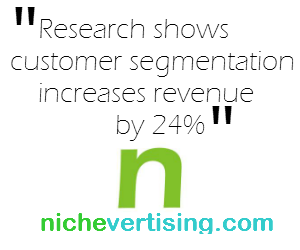 Customer segmentation is one of the most underutilized strategies by new entrepreneurs starting with email marketing for the first time. At first glance, new entrepreneurs view customer segmentation as a something they can defer until a dedicated marketing person is available to handle the details. So instead of building an email list with customer segmentation in mind from the start, new entrepreneurs assume it’s easier to start sending email newsletters that treat every email subscriber equally.
Customer segmentation is one of the most underutilized strategies by new entrepreneurs starting with email marketing for the first time. At first glance, new entrepreneurs view customer segmentation as a something they can defer until a dedicated marketing person is available to handle the details. So instead of building an email list with customer segmentation in mind from the start, new entrepreneurs assume it’s easier to start sending email newsletters that treat every email subscriber equally.
It is true that deferring your customer segmentation efforts may save a little time when you first start email marketing, but is saving as little as 30 minutes to an hour of setup time really worth it?
To answer this question, let’s first start with what the email marketing professionals think. In December 2012, eMarketer.com released data from email marketing professionalss with monthly email volumes of at least 50,000.
It turned out that customer segmentation was not only the #1 technique used by these email marketers, but also the most effective email marketing technique.
As a matter of fact, in the same research report from eMarketer.com, 82% of email marketing professionals stated that customer segmentation was not at all difficult. So there is really no reason that a multi-talented, scrappy entrepreneur like you shouldn’t be using customer segmentation too.
Here’s a summary of what the professionals say:
1. Customer segmentation is the most effective email marketing technique
2. Customer segmentation is the easiest techniques to implement
3. Customer segmentation is used more often than any other email marketing technique.
Why aren’t you segmenting your customer’s again?
At this point you should not have any excuses. So let’s just get started with a few baby steps.
Below I’ve listed two examples of the easiest ways to get started with customer segmentation in your email marketing campaigns.
1. Segment by who opens your emails
If you have an existing email marketing list that does not currently use customer segmentation, then the best thing you can do is send out an highly specific email with an offer targeting your ideal customer segment.
For example, if you are an ecommerce retailer selling clothes using Shopify, you could send out an email marketing campaign to your Shopify email list with a coupon code for a discount only on children’s clothes.
In this example, create a very specific email subject line describing this discount. Then each email subscriber that opens that email you will move to a new email list named “interested in children’s clothes” for example.
You could also do something similar for many other customer attributes such as sending out an email with the subject line offering a sale on clothes that are of a certain size, type (business attire, workout gear, etc), or gender based.
2. Segment by who does what on your website
If you are building a new email list, the easiest way to get started with customer segmentation in your email marketing campaigns is to create multiple entry points for new subscribers.
For example, as we pre-announced the early-adopter release of the Nichevertising web application, we began to build our email subscriber base of people who wanted to get early access. We also began to collect email subscribers of blog readers who wanted marketing tips sent to them weekly.
So we created two customer segments for the early-adopter release: one for entrepreneurs actively looking for a new advertising solution and another for researchers and journalist. We also created a third customer segment for people who were only blog readers and just wanted marketing tips.
To do this, within our email marketing system we created three different email list, each having a different sign-up form. We placed each of these three forms in different places throughout our website with unique call to action copy for each.
Now, each time we get a new email subscriber, we know exactly what motivated them to subscribe and we can target future email newsletters to those specific motivations.
You could do something similar by targeting your ebook, discount, or webinar offers to specific customer segments to create a variety of targeted email list.
Once you have your users segmented, there is a huge opportunity to increase your business results by sending out highly specific email campaigns to each segmented list. Researched published on HubSpot shows that email customer segmentation increases:
- Open rates by 39%
- Revenue by 24%
- Word of mouth by 14%
In addition, customer segmentation decreases:
- Unsubscribe rates by 28%
- Spam complaints by 15%
These are mind blowing improvements…It’s worth repeating…
Research shows customer segmentation increases revenue by 24%.
Wow! I don’t think there’s a need to say more.

There are 6 comments. Add yours.